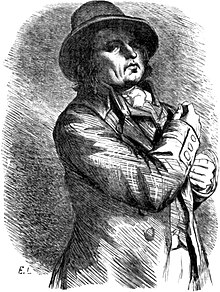Charles Henri Sanson
| Charles-Henri Sanson | |
|---|---|

Portrait of Charles-Henri Sanson
|
|
| Born |
15 February 1739 Paris, France |
| Died | 4 July 1806 (aged 67) Paris, France |
| Nationality | French |
| Occupation | Royal Executioner of France, High Executioner of the First French Republic |
Charles-Henri Sanson, full title Chevalier Charles-Henri Sanson de Longval (15 February 1739 – 4 July 1806) was the Royal Executioner of France during the reign of King Louis XVI, and High Executioner of the First French Republic. He administered capital punishment in the city of Paris for over forty years, and by his own hand executed nearly 3,000 people, including the King himself.
Charles-Henri Sanson was the fourth in a six-generation family dynasty of executioners. His great-grandfather, a soldier in the French royal army named Charles Sanson (1658–1695) of Abbeville, was appointed as Executioner of Paris in 1684. Upon his death in 1695, the Sanson patriarch passed the office to his son, also named Charles (1681- September 12, 1726). When this second Charles died, an official regency held the position until his young son, Charles John Baptiste Sanson (1719 - August 4, 1778), reached maturity. The third Sanson served all his life as High Executioner, and in his time fathered 16 children, 10 of whom survived to adulthood. The eldest of his sons, Charles-Henri - known as "The Great Sanson" - apprenticed with his father for 20 years, and was sworn into the office on 26 December 1778.
Charles-Henri Sanson was born in Paris to Charles-Jean-Baptiste Sanson and his first wife Madeleine Tronson. He was first raised in the convent school at Rouen until in 1753 a father of another student recognized his father as the executioner and he had to leave the school in order to not ruin the school's reputation. Charles-Henri was then privately educated. He had a strong aversion towards his family's business.
His father's paralysis and the assertiveness of his paternal grandmother, Anne-Marthe Sanson, led Charles-Henri to leave his study of medicine and to assume the job of executioner in order to guarantee the livelihood of his family. As executioner (bourreau) he came to be known as "Monsieur de Paris" - "Gentleman of Paris". On January 10, 1765, he married his second wife, Marie-Anne Jugier. They had two sons: Henri (1767–1830), who became his official successor, and Gabriel (1769–1792), who also worked in the family business.
In 1757 Sanson assisted his uncle Nicolas-Charles-Gabriel Sanson (1721–1795, executioner of Reims) with the extremely gruesome execution of the King's attempted assassin Robert-François Damiens. His uncle quit his position as executioner after this event. In 1778 Charles-Henri officially received the blood-red coat, the sign of the master executioner, from his father Charles-Jean-Baptiste and held this position for 38 years, until his son Henri in 1795 succeeded him after he showed serious signs of illness. The majority of the executions were performed by Sanson and up to six assistants. He was the first executioner to use the guillotine, executing Nicolas Jacques Pelletier, for robbery and assault, on April 25, 1792. The use of the guillotine transformed Sanson's status under the revolutionary ideology from outcast to citizen, equal in rights and civil duties.
...
Wikipedia
